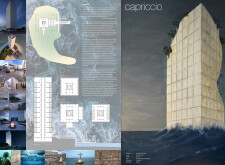5 key facts about this project
### Overview and Intent
Located along an undermined coastline, the Capriccio project presents a vertical cemetery that merges practical needs with profound emotional and philosophical considerations of memorialization. This architectural design prioritizes a balance between form and function while establishing relevance to its coastal context. The project aims to create an environment conducive to contemplation and remembrance, reflecting the complexities of life and death through its design.
### Integration with Natural Elements
The design fosters a conversation between the built environment and its natural surroundings, utilizing the tranquil coastal setting to enhance the experience of reflection. Central courtyards within the layout promote accessibility and encourage visitors to interact meaningfully with the space. The vertical arrangement signifies ascent and connection, allowing the structure to function as both a memorial and a prominent feature of the landscape. Incorporating light niches and green terraces, the project enhances its engagement with nature, providing visual continuity and a sense of hope.
### Materiality and Construction Techniques
The selection of materials is critical to the project's durability and aesthetic presence. Concrete serves as the primary structural element, ensuring resilience against coastal conditions, while marble cladding adds elegance and a reflective quality that harmonizes with the coastal light. The architectural integrity is maintained through innovative construction techniques that emphasize both the complexity of design and structural sustainability. This attention to material choice underscores the project’s dedication to enduring beauty and functionality in an ecologically sensitive area.






















































